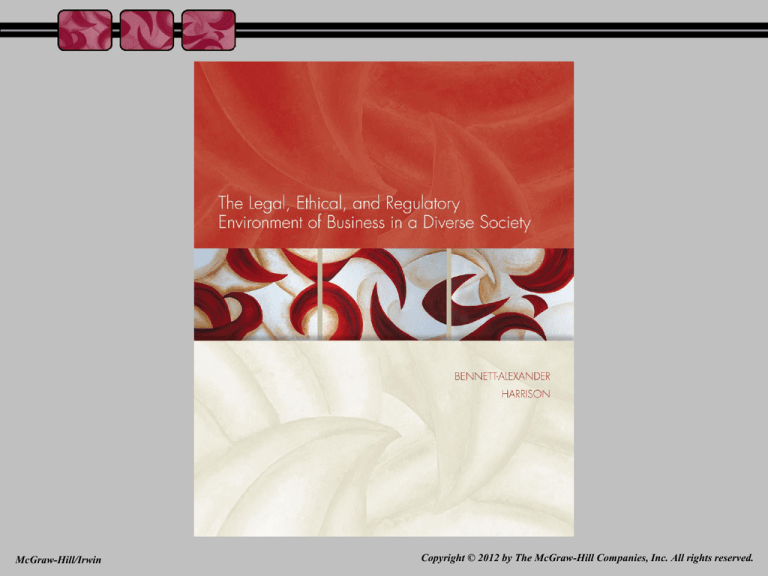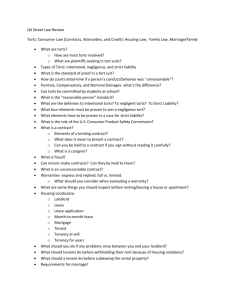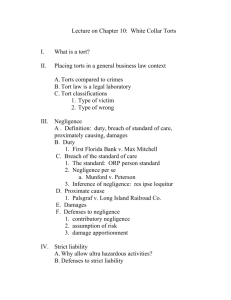
McGraw-Hill/Irwin
Copyright © 2012 by The McGraw-Hill Companies, Inc. All rights reserved.
6-2
Learning Objectives
Define what torts are and who commits them.
Recite the different categories of torts
Provide the requirements for a valid contract
Discuss the underlying basis for the different categories of torts
Discuss a business owner’s responsibility for torts committed by
employees
Define strict liability and give its defense
Recognize negligence actions and list the requirements and their
defenses
List the intentional torts and give the requirements for each well
as defenses
Define appropriate ethical considerations regarding torts
6-3
Torts - Definition
A Tort is a civil wrong.
Civil violations of law instead of
criminal.
The plaintiff (injured party) sues defendant
(tortfeasor) to receive compensation for
losses suffered by the tort being committed
against him or her.
6-4
Tort Categories
6-5
Intentional Torts
Intentional Torts Against the Person
Battery
Assault
False Imprisonment
Defamation
Intentional Infliction of Emotional Distress
(IIED)
Invasion of Privacy
6-6
Intentional Torts – Invasion of Privacy
Intrusion upon
seclusion
Appropriation of
name or likeness
False Light
Publication of
private facts
6-7
Intentional Torts Against Business
Disparagement
Intentional Interference with contractual
relations
Theft of Trade Secrets
Palming off
Infringements of trademark, trade name,
patents, copyrights (discussed in ch. 15)
6-8
General Defenses to Intentional Torts
Lack of
Intent
Consent
Defense of
Self or
Others
6-9
Negligence
• When a tortfeasor fails to meet a standard of
reasonable care and another is forseeably
subjected to an unreasonable risk of harm and is
injured as a result, the tortfeasor can be sued by
the injured party for negligence.
6-10
Negligence
Elements:
Duty
Breach
Causation
Damages
Actual Cause
Proximate Cause
6-11
Defenses to Negligence
6-12
Strict Liability
Strict liability is liability regardless of
fault
Imposed on tortfeasors for engaging in activity
deemed by statute to be so dangerous that the
tortfeasors must take responsibility for all harm that
arises therefrom, even if the tortfeasor was as careful
as possible.
Defense: Voluntary assumption of the risk
6-13
Product Liability
Liability imposed on product makers and
distributors for harm caused to people and
property by defective, unreasonably dangerous
products.
Theories for recovery:
Negligence
Strict Liability
Breach of Warranty
6-14
Product Liability
Recovery under
Negligence and Strict
Liability:
• Design Defect
• Manufacturing Defect
• Failure to warn
• Failure to adequately package
6-15
Product Liability
Recovery under Warranties:
Express Warranties
Implied Warranties
Warranty of Merchantability
Warranty of fitness for a particular purpose
6-16




